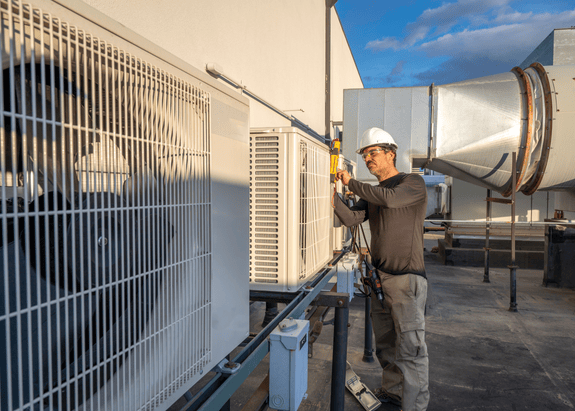How to Get Your Commercial HVAC System Summer Ready
Why Commercial HVAC Summer Maintenance Matters in Canada
As temperatures climb across Ontario, so do the complaints—from employees, tenants, or customers wondering why the A/C’s blowing lukewarm air like it’s trying to stir soup. If you’re in charge of a commercial space, it’s time to show that HVAC system some love before summer turns it into a glorified ceiling fan.
Whether you run an office, retail store, warehouse, or restaurant, prepping your HVAC system for the heat isn’t just a luxury—it’s a necessity. A few proactive steps today can save you from system breakdowns, high energy bills, and the dreaded “why is it so hot in here?” question every five minutes.
Let’s break it down step-by-step: what you can do yourself, what your HVAC technician should handle, and why it all matters.

Why Summer Prep Matters (And Why Procrastination Costs You)
Commercial HVAC systems are beasts. They work long hours, cool large areas, and if neglected, can cost you thousands in emergency repairs or lost productivity. Here’s why summer readiness is non-negotiable:
- Energy Efficiency: Dirty coils, clogged filters, or leaky ducts can send your energy bills skyrocketing.
- Air Quality: Summer allergens and pollutants build up fast. If your system’s not prepped, your indoor air turns into a sneeze-fest.
- System Longevity: Preventive maintenance extends the life of your HVAC system and keeps warranties intact.
- Comfort = Retention: Happy employees and comfortable customers stick around longer. It’s that simple.
Now, let’s get into the actual steps.
Step 1: Replace Air Filters to Improve Efficiency and Air Quality
Let’s not kid ourselves—if your filters look like they’ve been through a dust storm, it’s time. Dirty filters restrict airflow, make your system work overtime, and wreck indoor air quality. During peak cooling seasons, swap filters monthly, or every 3 months at minimum.
DIY Tip:
Buy filters in bulk (labelled MERV 8–13 for commercial buildings) and schedule a monthly reminder. Your system—and your sinuses—will thank you.
Step 2: Clean HVAC Coils to Maximize Cooling Performance
Both evaporator and condenser coils accumulate grime that insulates them from doing their job. This is like trying to cool your office with a snow cone inside a ziplock bag—ineffective and messy.
Technician Task:
A licensed HVAC tech should deep clean the coils at least once a year using a coil-safe cleaner and check refrigerant pressures to ensure peak performance.
Step 3: Inspect Belts, Motors, and Electricals to Prevent Breakdowns
Commercial HVACs run hard. Worn belts, loose electrical connections, or failing fan motors can sneak up and cause system failure at the worst time—like a heatwave or during your biggest client pitch.
Tech Must-Do:
Have a pro inspect belts, motor amperage, and electrical connections to catch issues before they boil over. Literally.
Step 4: Upgrade or Reprogram Your Commercial Thermostat
Still using an old-school manual thermostat? In a commercial building? It’s like using a flip phone to run your business – quaint, but not efficient.
What You Can Do:
- Adjust schedules for longer daylight hours.
- Use zoning to avoid cooling unoccupied areas.
- Consider upgrading to a smart thermostat with remote monitoring and data reports.
Step 5: Clean Air Vents and Ducts for Better Indoor Airflow
Dust, debris, mould spores, and even pests love to party in your ductwork. Dirty ducts reduce airflow, affect air quality, and make your HVAC work overtime.
When to DIY:
Vacuum visible vents and returns monthly. Remove grates and clean them with soap and water.
When to Call a Pro:
- If you see visible mould or smell musty odours.
- If there’s excessive dust buildup despite regular cleaning.
- If your system is older and hasn’t been cleaned in 3–5 years.
Step 6: Calibrate HVAC Control Systems in Your Commercial Building
Commercial systems often have complex Building Management Systems (BMS) or programmable logic controllers. If they aren’t calibrated or updated, you’re basically playing thermostat roulette. ️
What Your HVAC Pro Should Check:
- Setpoint controls
- Occupancy sensors
- Outdoor air intake settings
- Scheduling and override functions
Step 7: Check HVAC Drain Lines and Pans to Prevent Leaks
As systems cool the air, they remove moisture—aka condensation. That water has to go somewhere, and if your drain lines or pans are clogged, that somewhere is likely into your ceiling tiles. ️
Prevent This By:
- Flushing condensate drain lines regularly
- Cleaning or replacing rusty or damaged pans
- Checking for leaks or standing water around air handlers
Step 8: Seal HVAC Duct Leaks and Improve System Insulation
Poorly insulated ducts or leaky joints bleed cold air like a tire with a nail in it—your energy bills go up, and your cooling goes down.
What a Pro Should Do:
- Perform duct leak testing (using pressure gauges or smoke tests)
- Seal with mastic or metal-backed tape (never duct tape—ironic, right?)
- Add insulation in unconditioned zones like attics or crawlspaces
Step 9: Schedule a Professional HVAC Diagnostic Before Summer
The best summer prep ends with data. A certified HVAC technician should run a full system diagnostic, covering:
- Airflow measurements
- Refrigerant charge levels
- Compressor function
- Static pressure
- Thermostat accuracy
Bonus: Schedule Your Professional HVAC Maintenance in Spring (Not Mid-July)
Peak HVAC season = long wait times and premium rates. Beat the rush by booking a spring maintenance appointment, so you’re ready before the heat wave (and before your competition fills the technician’s schedule).
Watch for HVAC Red Flags That Signal Urgent Repairs
If you spot these signs, it’s time to stop DIY-ing and call in the cavalry:
- Uneven cooling or hot spots in your building
- Spikes in hydro bills without explanation
- Strange noises, rattles, or grinding
- Persistent musty smells
- Employees or customers complaining about air quality
Key Takeaways: Your Summer Commercial HVAC Prep Checklist
✅ Replace air filters✅ Clean coils
✅ Check belts, motors, and electricals
✅ Update your thermostat
✅ Clean vents & ducts
✅ Calibrate system controls
✅ Clear drain lines
✅ Seal and insulate ducts
✅ Get a full diagnostic
✅ Book professional maintenance
Final Word: Don’t Let Your HVAC System Call in Sick This Summer
Summer in Ontario can be brutal. But your building doesn’t have to be. Whether you’re managing a high-rise, shop floor, or office suite, preparing your commercial HVAC system now is the smartest move you’ll make all season.
You’ll boost efficiency, cut costs, and keep your indoor environment chill—literally and figuratively.

